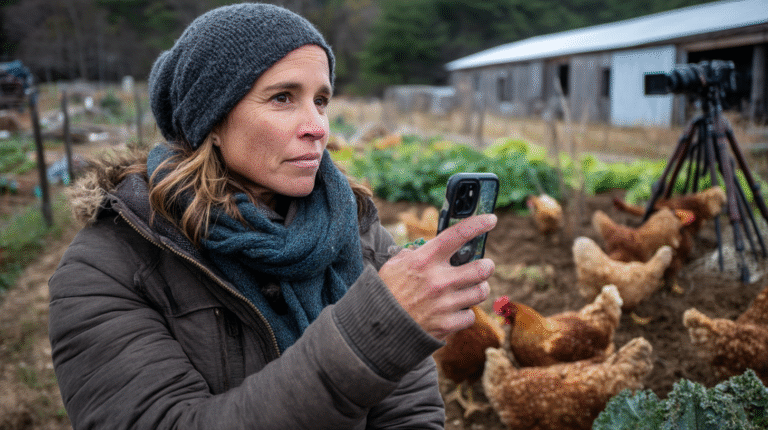Email Marketing for Small Farms: Building and Nurturing Your Customer Base
Email marketing provides your small farm direct access to customers, yielding $38 for every $1 spent.
Start by collecting emails at markets utilizing tablets or QR codes, then craft messages with farm updates, recipes, and behind-the-scenes glimpses.
Send weather-related alerts and harvest notifications to drive timely purchases.
Choose user-friendly platforms like Mailchimp or Flodesk that integrate with your existing tools.
The right strategy transforms subscribers into loyal customers who eagerly await your next message.
Key Takeaways
- Email marketing offers small farms a high ROI ($38 for every $1 spent) while building direct customer relationships without algorithm interference.
- Collect emails strategically through website sign-up forms, farmers market interactions, and local business collaborations rather than purchasing lists.
- Create engaging content featuring farm updates, seasonal recipes, behind-the-scenes glimpses, and customer testimonials to maintain subscriber interest.
- Leverage weather-based notifications and harvest alerts to provide timely, relevant information that positions your farm as a local expert.
- Choose appropriate email tools with automation features to save time during busy seasons while tracking key metrics for continuous improvement.
Want to Learn How to Rank #1 in Your Town?
Get the free checklist: “The 5 Quick Fixes to Get Found on Google Maps.”
Why Email Marketing Is Essential for Small Farm Success
Three powerful words can transform your small farm: direct customer access.
Unlike social media where your posts compete with thousands of others, email lands right in your customers’ inboxes. No algorithms to fight. No paid ads needed.
Think about it: for every $1 you spend on email marketing for farms, you’ll see an average $38 return! That’s some serious ROI.
Email marketing delivers a staggering $38 return on every dollar spent—transforming your farm’s finances while connecting directly with loyal customers.
Why does it work so well?
- Your messages reach customers directly
- You build personal relationships with regular updates
- You control when and what to communicate
- You can track what resonates with your audience
Even better? You don’t need fancy tech skills to get started.
Email marketing gives small farms a fighting chance against bigger competitors with deeper pockets.
While social platforms limit visibility, your emails will reach all your subscribers regardless of changing algorithms.
Farms implementing consistent email marketing campaigns experience a remarkable 23% annual sales growth according to Local Line data.
Getting Started: Building Your Farm’s Email List From Scratch
Ready to turn those email marketing benefits into reality? Building your first email list doesn’t require tech wizardry – even beginner SEO farmers can handle this!
Start with clear, achievable goals – maybe 25 new subscribers weekly. Quality beats quantity every time.
Three easy ways to grow your list:
- Add sign-up forms prominently on your website (bonus points for offering a free recipe guide!)
- Collect emails in person at farmers markets using a tablet or simple QR code
- Partner with local businesses for cross-promotion
Don’t overcomplicate things! Just ask for name and email – nothing more. Implementing a convenient web pop-up form on your website can significantly drive new business.
Remember: purchased email lists violate anti-spam laws and perform terribly. Your homegrown list will serve you better. Create compelling lead magnets that align with what your audience values to increase conversion rates.
Crafting Compelling Content That Resonates With Your Audience
When you’ve built a solid email list, your next challenge becomes filling those inboxes with content your farm fans actually want to read.
Local growers who nail their content strategy gain visibility that even bigger competitors can’t match.
What works? Think variety:
- Farm updates about what’s growing now
- Simple recipes featuring your seasonal produce
- Behind-the-scenes peeks at daily farm life
- Customer stories that showcase real results
- Quick educational tips on food preservation
The magic happens when you balance educational content (like composting guides) with promotional offers (early CSA signups). Maintaining a consistent sending schedule helps establish expectations and keeps your farm top-of-mind with customers.
Don’t overthink it! Your authentic farm voice is what subscribers crave—not perfectly polished corporate-speak.
Mix in user-generated content like customer photos to build community trust.
Remember that your emails should remain focused on products you offer, avoiding irrelevant content that distracts from your farm’s offerings.
Seasonal Strategies: Timing Your Farm’s Email Campaigns
Your email timing can make or break your farm’s marketing success.
Consider sending automatic harvest alerts when your tomatoes ripen or special weather-related offers when that first frost is coming.
These perfectly-timed triggers will help you connect with customers exactly when they’re most likely to buy, turning your seasonal challenges into marketing opportunities. Automating these timely messages using real-time inventory data creates an enhanced customer experience while significantly boosting engagement rates. Consistent email scheduling helps build subscriber anticipation and trust, making your farm communications more effective.
Harvest Timing Triggers
Throughout the year, small farms experience dramatic shifts in what’s ready for harvest—creating perfect opportunities for email campaigns that drive sales and enthusiasm.
Think of your harvest schedule as your marketing calendar!
When those heirloom tomatoes finally ripen, your email list should be the first to know. This simple local SEO farming strategy helps you compete with bigger operations who can’t match your freshness factor.
Try these trigger points:
- New crop availability (“First strawberries of the season!”)
- Peak harvest abundance (“Zucchini overload – special pricing!”)
- Limited-time offerings (“Last chance for sweet corn!”)
Adjust your email frequency based on what’s happening in your fields. During summer abundance, weekly updates keep customers engaged. Remember to limit your emails to 4-8 per month for optimal engagement, especially if your subscriber list is between 2,000-5,000 contacts.
Your email campaigns will generate significantly more customer conversions than posting the same information on social media platforms alone.
During slower seasons, monthly check-ins maintain connection.
Those emails won’t write themselves!
Weather-Based Email Alerts
Beyond harvest calendars, Mother Nature adds another layer to your marketing strategy. Smart farmers are using weather as a competitive edge in their emails.
You don’t need fancy SEO help farms can’t afford—just timely alerts that show you’re paying attention:
- Send frost warnings with quick protection tips for customers’ home gardens
- Alert subscribers about heavy rain affecting weekend markets
- Share drought updates with water conservation suggestions
Set up simple triggers using weather APIs that notify customers about:
- Irrigation needs during dry spells
- Storm preparation for livestock
- Ideal planting conditions after rain
These micro-targeted messages enhance engagement while positioning you as the local expert. Consider using applications like Custom Weather Alerts that offer customizable notifications for various weather conditions. Integrating high-resolution forecasts with hourly predictions for specific locations can dramatically increase the accuracy and value of your weather-based emails.
Your bigger competitors? They’re still sending generic weekly newsletters while you’re delivering exactly what your community needs, exactly when they need it.
Tools and Software to Streamline Your Farm’s Email Marketing
Acquiring the right email marketing tools can make all the difference for your farm’s success.
You’ll want to select a platform that fits your specific needs—whether that’s Mailchimp for its versatility or Flodesk for its user-friendly design and affordable pricing.
The best systems offer customizable templates and automation features that’ll save you precious hours during busy harvest seasons. Integrating Mailchimp’s Customer Journey Builder can help create personalized email sequences that respond to specific buyer behaviors, potentially increasing your monthly sales by up to 28%. Before committing to a platform, carefully evaluate your near-term goals to ensure the service aligns with your communication frequency and marketing strategy.
Choosing the Right Platform
How do you pick the perfect email marketing platform when there are so many options out there?
It’s like basic SEO tips – no tech expertise required, just smart choices!
Consider these essentials:
- Affordability – Many platforms offer free plans for small subscriber lists.
As you grow, costs typically increase, though some like Flodesk offer flat-rate pricing.
- Integration – Look for platforms that connect with your existing tools (Square, Shopify, farm management software).
- Ease of use – Drag-and-drop builders and pre-designed templates make creating professional emails simple.
- Features – Prioritize segmentation, analytics, and basic automation.
- Deliverability – Make sure your emails actually reach inboxes, not spam folders.
Take advantage of free trials (usually 14 days) to test before committing.
Automation Saves Time
While tending to your crops demands constant attention, your email marketing shouldn’t. Smart automation tools can work silently in the background while you focus on farming.
Pre-built sequences handle the heavy lifting:
- Welcome emails for new subscribers
- Order confirmations sent instantly
- Abandoned cart reminders (because life happens)
You don’t need complex tech skills – these systems are designed with easy farm SEO in mind. Just set up once, then watch them work!
Want to know when people actually read your emails? Real-time analytics track opens and clicks so you can see what resonates.
The best part? Many platforms offer free starter plans for small operations. Start with simple automations like birthday messages or harvest announcements – they’ll feel personal while saving you precious hours.
Automation is your behind-the-scenes farmhand!
Templates Worth Using
Every successful farm email campaign starts with a solid template. You don’t need to reinvent the wheel with each message you send!
Several excellent options make this process painless:
- MailChimp offers user-friendly templates that even tech-novices can excel at
- Local Line provides free marketing templates specifically designed for farms
- Anna Fleishman Design creates customizable templates that maintain your brand identity
These templates help you stay consistent across all communications – vital for google profile SEO and local visibility.
Think of them as your farm’s digital uniform!
The best part? Most templates integrate with tracking tools so you can see what’s working.
Which emails are customers opening? What links are they clicking?
Find one that feels right for your farm and run with it.
Measuring and Analyzing Your Email Campaign Performance
Tracking your email campaign results isn’t just busywork—it’s your secret weapon for continuous improvement. Just like smart SEO for growers helps you stand out locally, good email metrics tell you what’s working.
Five key metrics to monitor:
- Open rate (aim for 35%+)
- Click-through rate (2.5% is solid)
- Bounce rate (lower is better)
- Conversion rate (shows if people take action)
- Unsubscribe rate (keep under 0.5%)
Review these numbers monthly and look for patterns. Did that recipe newsletter crush it? Did your harvest update fall flat?
The data doesn’t lie! Utilize A/B testing on subject lines to enhance opens.
And don’t forget to segment your list—targeted emails perform way better.
Privacy Compliance and Best Practices for Agricultural Businesses
Now that you’re tracking your email success, let’s talk about keeping your subscribers’ information safe.
Privacy compliance isn’t just for tech giants—it matters for your farm too!
As a small farmer, you need to:
- Get clear permission before adding folks to your list
- Only collect data you actually need
- Be transparent about how you’ll utilize their information
- Keep their data secure (password-protect everything!)
Remember: building trust with customers means respecting their privacy. Your farm might be small, but your commitment to data protection should be mighty!
When someone shares their email with you, they’re giving you a piece of their digital property.
Treat it with the same care you’d want for your fields.
Related Questions
How Often Should I Email My Farm Customers Without Annoying Them?
You’ll find a sweet spot by emailing weekly during peak season and biweekly or monthly otherwise. Test different frequencies and watch your open rates—your customers will tell you when it’s too much or too little.
Can I Use Customer Photos in My Farm Emails?
Yes, you can utilize customer photos in your farm emails, but you’ll need written permission first. Always get explicit consent, especially for images with children, and offer clear opt-out options in your email footers.
What Subject Lines Get the Highest Open Rates for Farm Emails?
Subject lines that include urgency, personalization, and curiosity get the highest open rates. Try “Last chance for your strawberries 🍓,” “What’s growing in your box this week?” or “[Name], your favorites are back!” Keep it under 50 characters.
How Do I Recover From a Drop in Email Engagement?
To recover from dropping engagement, segment your inactive subscribers, send targeted re-engagement emails with valuable content, clean your list by removing long-term non-responders, and test different subject lines and send times for better results.
Should I Offer Different Content to CSA Members Versus Regular Customers?
Yes, you should offer different content to CSA members versus regular customers. They have different relationships with your farm. Tailor messages to CSA members with exclusive updates while keeping regular customers informed about general offerings.
What it all boils down to
You’ve got everything you need to transform your farm’s marketing approach now! Start collecting emails today, nurture those relationships with valuable content, and watch your customer base grow alongside your crops.
Email marketing isn’t just another task—it’s cultivating community around the food you pour your heart into growing.
Your inbox is fertile ground for farm success.





